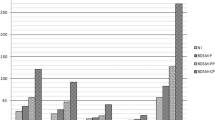Abstract
Intimate partner abusers often focus on physical violence, but abuse may also include exploiting a partner’s faith or subculture. Alternatively, faith or subculture may be a source of strength and support for victims. We explored this by analyzing case files from a Jewish domestic violence services agency. Jewish identity conditions women’s experiences with intimate partner abuse through the use of Judaism as a “tool” for abuse, the role of Jewish holidays and observances, and the role of the Jewish community. While partners of abused Jewish women often perverted the laws and traditions of Judaism to control their partners and the reaction of the larger community varied, being part of an integrated cultural and religious community offered support for some women.
Similar content being viewed by others
References
Cwik, M. S. (1995). Couples at risk? A feminist exploration of why spousal abuse may develop within Orthodox Jewish marriages. Family Therapy, 22(3), 165–183.
Cwik, M. S. (1996). Peace in the home? The response of rabbis to wife abuse within American Jewish congregations—Part 1. Journal of Psychology and Judaism, 20(4), 275–348.
Dehan, N., & Levi, Z. (2009). Spiritual abuse: an additional dimension of abuse experienced by abused Haredi (Ultraorthodox) Jewish wives. Violence Against Women, 15(11), 1294–1310.
DeVoe, E. R., Borges, G., & Conroy, K. (2001). Domestic violence and the Jewish woman: an exploratory study. Journal of Religion & Abuse, 3(1/2), 21–46.
Epstein, M. (1989). A woman’s guide to the get process. Brooklyn: Author.
Giesbrecht, N., & Sevcik, I. (2000). The process of recovery and rebuilding among abused women in the conservative evangelical subculture. Journal of Family Violence, 15(3), 229–248.
Gillum, T. L., Sullivan, C. M., & Bybee, D. I. (2006). The importance of spirituality in the lives of domestic violence survivors. Violence Against Women, 12(3), 240–250.
Graetz, N. (2005). The battered woman in the Jewish tradition: see no evil, hear no evil, speak no evil. Journal of Religion & Abuse, 6(3/4), 31–48.
Grodner, E., & Sweifach, J. (2004). Domestic violence in the Orthodox Jewish home: a value-sensitive approach to recovery. Affilia, 19(3), 305–316.
Johnson, M. P. (1995). Patriarchal terrorism and common couple violence: two forms of violence against women. Journal of Marriage and the Family, 57(2), 283–294.
Johnson, M. P. (2008). A typology of domestic violence: intimate terrorism, violent resistance, and situational couple violence. Boston: University Press of New England.
Johnson, M. P., & Leone, J. M. (2005). The differential effects of intimate terrorism and situational couple violence: findings from the National Violence Against Women Survey. Journal of Family Issues, 26(3), 322–349.
Kirkwood, C. (1993). Leaving abusive partners. Thousand Oaks: Sage Publications.
Knickmeyer, N., Levitt, H. M., Horne, S. G., & Bayer, G. (2003). Responding to mixed messages and double binds: religious oriented coping strategies of Christian battered women. Journal of Religion & Abuse, 5(2), 29–53.
Lebovics, S. (1998). The observant Jewish victim of spouse abuse: dynamics and countertransference issues. Journal of Psychology and Judaism, 22(2), 91–100.
Leone, J. M., Johnson, M. P., Cohan, C. L., & Lloyd, S. E. (2004). Consequences of male partner violence for low-income minority women. Journal of Marriage and Family, 66, 471–489.
McWilliams, M. (1998). Violence against women in societies under stress. In R. E. Dobash & R. P. Dobash (Eds.), Rethinking violence against women (pp. 11–140). Thousand Oaks: Sage.
Palant, E. (2005). A shelter for Orthodox Jewish women in Israel: the experience of helping religious women escape domestic abuse. Journal of Religion & Abuse, 6(3/4), 19–29.
Pence, E., & Paymar, M. (1993). Education groups for men who batter: The Duluth Model. New York: Springer Publishing Company.
Ringel, S., & Bina, R. (2007). Understanding causes of and responses to intimate partner violence in a Jewish Orthodox community: survivors’ and leaders’ perspectives. Research on Social Work Practice, 17(2), 277–286.
Sharhabani-Arzy, R., Amir, M., Kotler, M., & Liran, R. (2003). The toll of domestic violence: PTSD among battered women in an Israeli sample. Journal of Interpersonal Violence, 18(11), 1335–1346.
Stark, E. (2007). Coercive control: How men entrap women in personal life. New York: Oxford University Press.
Sweifach, J., & Heft-LaPorte, H. (2007). A model for group-work practice with ultra-Orthodox Jewish victims of domestic violence: a qualitative study. Social Work with Groups, 30(3), 29–45.
Twerski, A. J. (1996). The shame borne in silence. Pittsburgh: Mirkov Publications.
Author information
Authors and Affiliations
Corresponding author
Additional information
The authors wish to thank the board and staff of the agency, Lisa Michels for her help in coding of case files, and David Hirschel, Barry Ruback, and anonymous reviewers for comments on earlier drafts. Data and funding for this research were provided by SHALVA. The views in this article may not necessarily reflect the views of SHALVA.
Rights and permissions
About this article
Cite this article
Cares, A.C., Cusick, G.R. Risks and Opportunities of Faith and Culture: The Case of Abused Jewish Women. J Fam Viol 27, 427–435 (2012). https://doi.org/10.1007/s10896-012-9435-3
Published:
Issue Date:
DOI: https://doi.org/10.1007/s10896-012-9435-3




